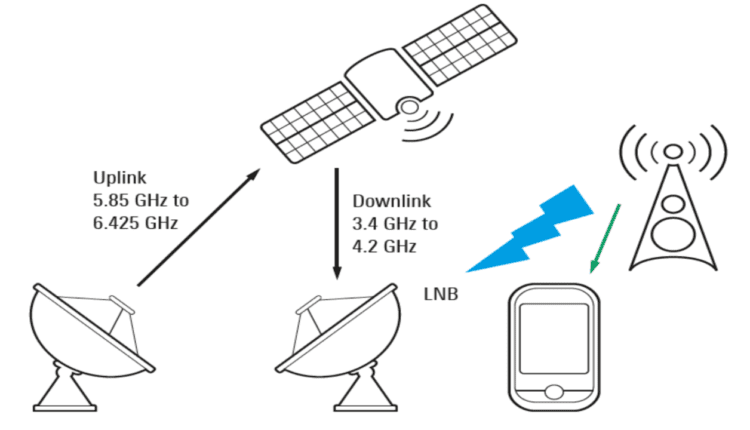C-Band TV Signal 5G Interference Solution?
 C-Band TV Signal 5G Interference Solution C-BAND 5G LNB[/caption]
C-Band TV Signal 5G Interference Solution C-BAND 5G LNB[/caption]What is C-Band TV Signal 5G Interference Solution?
C-Band, TV Signal, 5G Interference, Solution, Satellite TV, Mobile Tower, Antenna Interference, LNBF, LNB, Band Pass Filter, Rejection Bandpass Filter, Telecom, Broadcasting.
In this post, we will explore what a C-Band TV signal is, how it works, and the recent interference issues it has faced due to the deployment of 5G networks. We will discuss the challenges and potential solutions for reducing this interference and ensuring uninterrupted C-Band TV signal transmission for viewers. If you're interested in telecommunications technology and its impact on television broadcasting, this post will provide valuable insights.
A C-band TV signal is a type of satellite signal that is used for transmitting television programs. However, the introduction of 5G technology has caused concerns about interference with these signals. This interference can cause problems such as poor signal quality and disrupted transmission. In response, a solution has been developed that involves the use of filters and other technology to mitigate the interference caused by 5G signals. This post will explain what a C-band TV signal is, how 5G technology can interfere with it, and how the C-band 5G interference solution works. It will also provide information on the benefits of this solution and how it can be implemented.
What is C-Band 5G Interference and How to Solve it?
The rollout of 5G mobile towers has brought about a new challenge for those who rely on C-Band dish antennas to receive satellite TV signals. This is because both the 5G mobile signals and the TV signals use the same frequency band, leading to interference and signal disruption. The interference caused by 5G C-Band signals may affect the quality of commercial and free-to-air TV broadcasts.
Fortunately, there are solutions to this problem. To determine if the TV signal disruption is caused by 5G interference, you can compare the date of the 5G launch in your area with the date of the TV signal freezing. If the dates match, then 5G interference may be the issue.
It's worth noting that various factors can interfere with 5G signals, including physical obstacles. This is particularly challenging for indoor propagation, which is one of the biggest hurdles for 5G to overcome. Nonetheless, with the right approach, it's possible to mitigate the impact of 5G interference on C-Band dish antennas and enjoy uninterrupted TV viewing.
Here is a list of 5G bands in India:
- 600MHz- n71
- 700MHz- n28
- 800MHz- n5
- 900MHz- n8
- 1800MHz- n3
- 2100MHz- n1
- 2300MHz- n40
- 2500MHz- n41
- (3300 – 3800MHz)- n78 – (This band is used by C-Band Television Broadcast)
- (3300 – 4200MHz)- n77 – (This band is used by C-Band Television Broadcast)
- (4400 – 5000MHz)- n79
- 26GHz (24.25 – 27.5 GHz)- n258
If you are experiencing 5G C-Band interference, you should identify which type of interference you are experiencing. The bands 3300-3800MHz (n78) and 3300-4200MHz (n77) are used by C-Band television broadcast, and interference with these bands may affect your TV signal reception.
Interference in 5G Signals –
The issue of 5G antenna interference can be divided into three parts, which many digital headend or cable operators in India face. To solve the issue, first, we need to identify the problem and then provide a solution.
Low 5G Interference –
Several cable operators have complained about low 5G interference in their TV signals, particularly for Intelsat 17 and Asiasat 5 satellites. If only some channels are freezing, then the problem could be due to low 5G network interference. A cheap 5G filter LNB can be installed to fix the issue.
Solution – If the dish antenna is two or more kilometers away from the mobile tower, the Solid 5G LNBF can be used.
Medium 5G Interference –
If the entire frequency of Intelsat 17 and Asiasat 5 satellite or any other satellite is lost, then the issue could be due to medium 5G interference. In such cases, a good 5G LNB of the best brand with an inbuilt bandpass filter is recommended.
Solution – If the dish antenna is within two kilometers or below, the SOLID 5G 82155R LNB can be used.
High 5G Interference –
When some channels' signals disappear, and only a few are coming through, the issue could be due to high 5G interference. In this scenario, a 5G LNB with a TI filter and a 5G interference rejection bandpass filter must be used. This solution is used by most significant cable companies, including government broadcasting-related agencies, and is the best C-Band 5G interference solution.
Solution – If the dish antenna is within 500 meters or below, none of the 5G LNB or LNBF will work. A 5G rejection bandpass filter must be used, which is expensive but the final solution to the high 5G interference issue.
